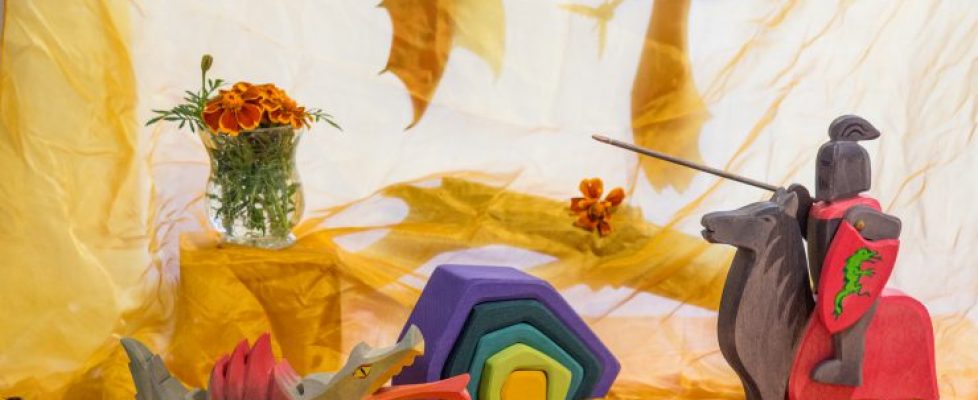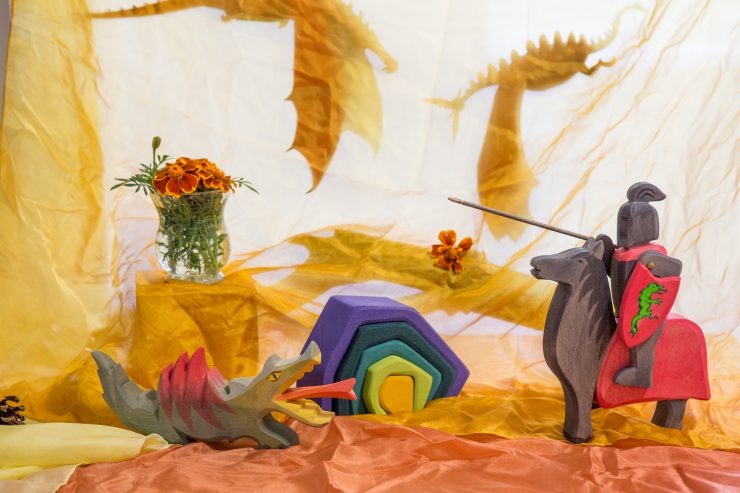Celebrating Michaelmas
If like me you grew up in a tradition that did not observe Michaelmas, you might be at a loss regarding its significance; you might also wonder how to bring it to your children if the Christian stories do not fit within your family’s faith. Marking the day so close to the equinox draws our attention to the changes in our world. It can be a really beautiful way to bring our children’s attention to the season’s change in the natural world and the way the shift from summer to autumn is reflected in our inner worlds.
Saint Michael is an archangel in Judaic, Islamic, and Christian traditions, and Michaelmas is a festival celebrated in some Christian communities. It is also one commonly celebrated in the Waldorf community. Saint Michael is honored for fighting against the powers of darkness and hurling Lucifer from heaven. Through his strength and courage, he rallied those around him to accomplish these feats. September 29, just after the autumnal equinox, is his feast day and it is treated like a harvest celebration with a focus on the gathering in and storing away of all we need for the coming winter. Much like the festivals in December that mark the returning of the light, the focus of this festival is about the light each of us carries in the world.
We can easily observe the squirrels and birds shifting their behavior as the days get shorter and colder in September; they gather for flight, or they scamper hurriedly between hidey holes. Insects, frogs, and fish all have their own patterns they follow to ready for the winter ahead. People, just like other animals, respond to the shifting weather from summer to fall with the urge to prepare. We might not need to fill our cupboards with enough food to last through the winter, but we do button up our homes, get out our winter clothes, and make sure our gardens are put to bed. The shorter days fill us with a need to hurry, to get ready for the coming cold and dark.
This antsy feeling can also manifest as a need to take personal stock. We might look at our relationships and our behaviors to see how we measure up to our ideals. Do we have the fortitude to nurture ourselves and our relationships through the long, dark days between the equinoxes? And that exact question can fuel the way you bring Michaelmas to your children. When his story does not fit with your faith, you still might find it speaks to your heart and the experience of readying yourself for the challenges of winter.
The story of St. George fighting the dragon is frequently told in Waldorf schools around this time of year. St George is a symbol of each of us rallying our courage to face our fears. He slew the dragon with the help of St. Michael, according to legend, thus ending the human sacrifices being offered to it. This imagery of human conquering beast is often found across cultures and faiths, perhaps demonstrating the power of this type of story. We can be inspired by such acts to feed the fire of our determination and courage to act humanely. Our unique light can help us fight for the good and true, hewing to our beliefs and values.
There are a few traditions that might add some fun and flavor to your Michaelmas. Because Lucifer supposedly landed on a briar making the fruit inedible, people are not ‘supposed’ to pick blackberries after Michaelmas. Adding blackberries to your menu can mark this tale. Many families make dragon bread for the feast day. Using a sweet, milk bread recipe with added raisins, you form the loaves into a dragon shape. Use seeds to ornament the dragon with scales or teeth. You can also use marigolds to decorate or dye fabric to mark the day. You can share the stories of St George or St Michael with your children. There are lovely, illustrated versions of the legend of St. George that you can find at your library. You could also read other dragon stories, like The Dragon’s Hoard or The Reluctant Dragon. The first title shares Viking tales and the second shows a more cooperative relationship between the dragon and the knight. Once you’ve read the stories, you can help your children put on a play or use their dollhouse figures to act it out.
So, make a dragon cake, add some marigolds to your nature table, or read lots of stories about dragons. Get out the mittens, stir the fire, and find the element that brings the most meaning to you and your children.


